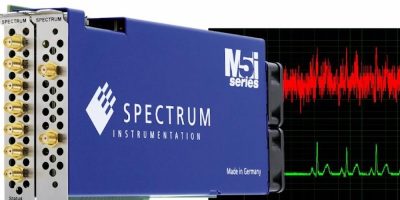Spectrum introduces firmware option for FPGA-based averaging digitisers
To reduce signal noise and improve resolution and dynamics, Spectrum Instrumentation has introduced a firmware option that allows the company’s high-speed M5i digitiser cards to perform on-board summation averaging.
Averaging is a useful tool for reducing unwanted signal noise, while improving measurement resolution, dynamic range and signal to noise ratio (SNR). The firmware option enables the M5i digitisers to perform the averaging function by using advanced, on-board, FPGA technology, explained Spectrum.
The M5i series digitisers deliver real time sampling at rates up to 6.4Gsample per second with 12-bit resolution and can stream the acquired data directly over the PCIe bus at 12.8Gbyte per second – a record breaking speed, said Spectrum. This is further enhanced by the new firmware option, said the company, which permits acquired signals to be averaged at 15 million events per second.
FPGA-based processing allows “ultra fast” averaging, even on complex and long waveforms, said Spectrum’s director of technology, Oliver Rovini. There is sufficient processing power available to average waveforms that contain as many as 1 MSample per acquisition, he continued. “The result is an averaging package that will be of interest to anybody working with high frequency signals or very narrow pulses that are low level or where signal details are being lost due to high amounts of noise.”
Typical applications include mass spectrometry, lidar, radio astronomy, automation, radar, biomedicine, nuclear physics, communications and sonar.
Summation averaging is a common, time domain based, processing technique that is used to reduce the random (uncorrelated) noise component of a signal, improving its SNR, while increasing a digitiser’s measurement resolution and dynamic range.
To further enhance the averaging capability, and allow the M5i series digitisers to detect and average rare events that might otherwise be lost in excessive background noise, the new firmware option includes a data suppression technique called threshold defined averaging (TDA). TDA allows the user to set a threshold level so that only waveform samples exceeding the level contribute to the accumulated waveform. Baseline noise samples, those that fall below the set level, are then suppressed by being set to zero, or, as an alternative, to a user-defined value.
As any waveform data that is below the threshold is removed from the averaged waveform, TDA can be a very useful tool for rejecting low level, correlated (synchronous) noise and other waveform artifacts, such as baseline drift. These are signal anomalies that cannot be removed by a conventional summation averaging process.
The averaging option (M5i.33xx-spavg) is available now for the M5i.33xx series of PCIe high-speed digitisers.

